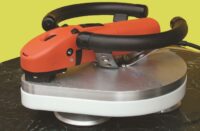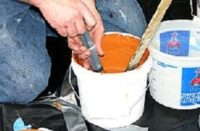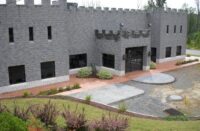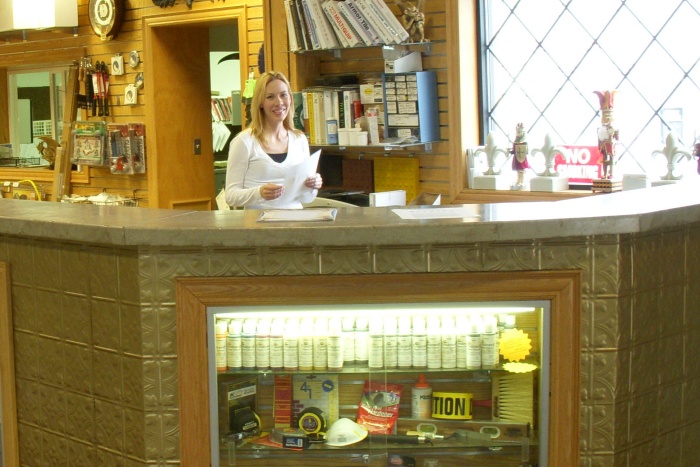Home prices are wobbling, new construction rates are stalling, unemployment figures are rising, and credit markets remain frozen. It’s pretty much the definition of a perfect storm for the construction industry and retailers alike.
“Not much of anything is selling right now,” observes Brad Struiksma, purchasing manager for the 10-store California retail chain Resource Building Materials. “Every category is falling. But decorative concrete is holding its own.”
Even in the current economic climate, there is some good news for decorative concrete product resellers. Of several contacted recently by Decorative Concrete Retailer, every one was doing at least as well with decorative concrete materials as with any other construction product category. In some cases, decorative concrete materials have been the difference between profit and loss. Product manager Ryan McCreery, who was hired to ramp up decorative concrete sales at Indianapolis-based Jobsite Supply, admits that the current economic situation is the worse he’s seen in his four years at the construction supply company. However, he says, DC is one of the fastest-growing segments of his business. His customers are particularly interested in stamped and polished concrete, overlays, stains, and concrete countertops, but all DC materials are doing well, he says. “It’s everything… DC in general has increased noticeably.”
Zack Ellis, a general manager at Concrete Design Center in the Dallas-Forth Worth region of Texas, is even more optimistic. “We’re holding steady,” he says. “Business is better now than it’s been in the last four or five years. We’re seeing lots of new construction, and decorative concrete is selling.” Ellis says that his customers seem to be focusing in particular on sealers, stains, mop-on waxes, and water-based and solvent-based dyes. “Acid stains are one of our biggest sellers,” he adds.
Displayed to advantage
Struiksma of Resource Building Materials has noticed that the stores in his chain that do the best business in decorative concrete are those that do the best job of merchandising. “In-store displays definitely help sell what we’ve got,” he says. “Our stores that have decorative concrete in view, or with product literature on display, do a lot better than those that keep their DC products in back.”
It might seem like Merchandising 101 to make your inventory visible to customers, but that’s not always a realistic option when decorative concrete products are competing with other niche categories. For some in the construction supply trade, decorative concrete is a secondary line that takes up as little as 10 to 15 percent of the store’s shelf space.
Also, because contractors are often the primary target market, supply store managers aren’t always in the habit of thinking like retailers. Professionals tend to be surer of what they’re looking for than homeowners, so they’re less apt to make impulse buys or be swayed by an attractive counter display.
“The majority of our (decorative concrete) inventory is in our warehouse area,” admits Jeff Patterson of Muller Construction Supply in San Jose, Calif.
Muller offers a complete line of concrete accessories at four northern California locations. Its largely contractor customer base wants everything from tools and power equipment to safety supplies and concrete mixes and grout. There’s simply no room to properly showcase the company’s decorative concrete offerings, including the sealers, water-based stains, dust-on color and dust-on release agents that are its top sellers within the category. And there’s little incentive to do so, since such a low percentage of store sales comes from walk-in retail trade.
But Patterson makes the best of the situation. “We’ve got photo displays up front, along with 12-by-12 samples of stamped and treated concrete. We try to grab as much attention as possible.”
That’s the key to making the most of the space you have and adapting the visual mindset of a retailer, even if the bulk of your business is with contractors.
Get creative. You might not be able to justify giving shelf space to everything you carry within the DC category, but make the setting as inviting as possible. Or at least try to prominently display your manufacturers’ POP material. It could make a difference in your bottom line.
If you need further incentive, think of your contractors’ potential as sales agents to home and building owners. One of Jobsite Supply’s competitors in the Indianapolis area is an installer/distributor with a location that makes contractors hesitant to send their clients there, McCreery says. That’s spurred him to make general customer appeal something of a New Year’s resolution. “Our goal is to expand and upgrade our building and create a much nicer display area,” he says. “We want to support our contractors and create an environment where local end-users feel comfortable coming and where contractors feel comfortable sending them.”
Ahead of the concrete curve
It’s vital to keep up with industry trends and technology and to stock what’s intriguing your customers – even before they know it. So when it comes to decorative concrete, wise suppliers will stay educated and make sure employees know what they’re selling.
One way to stay ahead of the curve is to piggyback on the positive publicity generated by the nation’s growing eco-friendly movement by carrying a full line of “green” decorative concrete products.
“We’re seeing more of a focus on green building and LEED (Leadership in Energy and Environmental Design) practices,” says McCreery. “Customers are asking for products like low-VOC water-based stains, so we carry them.”
Bright, vibrant color is another trend worth exploiting – at least in most markets. “While color is very popular in California, the earth tones seem to be more accepted (in Indianapolis),” McCreery says.
In any case, he is ready if West Coast style should make its way to the heartland. “In general,” he says, “if it’s on a color hardener chart, we’ve got it.”













